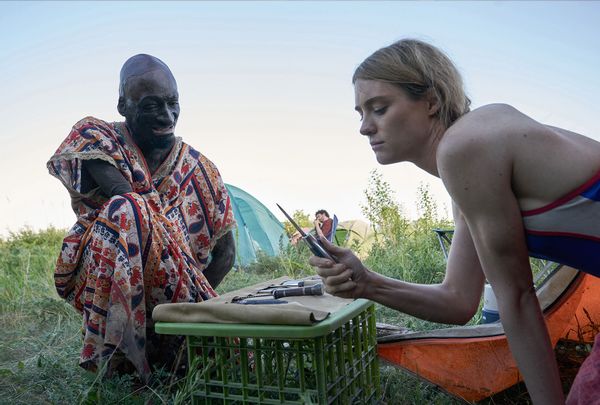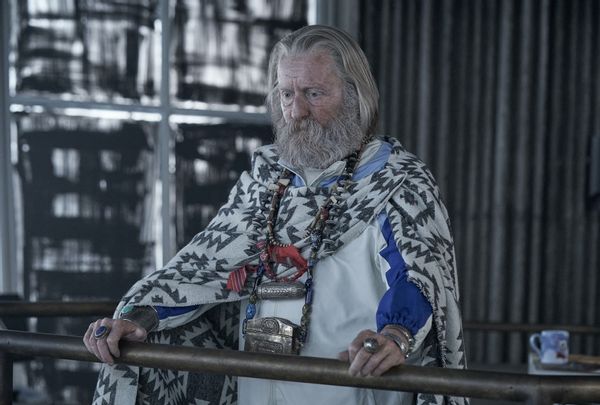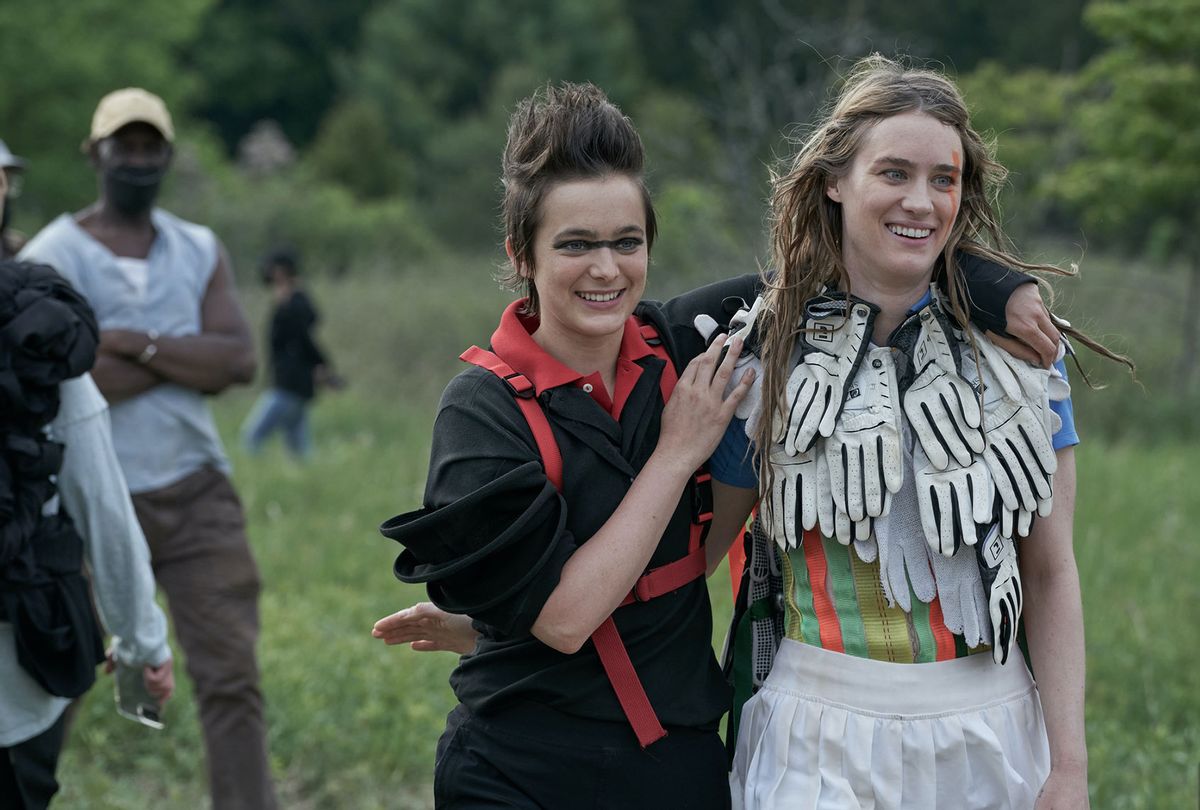The main hook of "Station Eleven" is simply feeling. It is the proverbial "you'll laugh, you'll cry" kind of show, which isn't a phrase we typically associate with a story about a world that emerges from an annihilating pandemic.
But in the way of all successful, meticulously realized works, Patrick Somerville's adaptation of Emily St. John Mandel's 2014 novel speaks to us in ways that aren't overtly written into the script. Helen Huang's costumes, for one, speak a dialogue all their own.
The Emmy Award-winning costume designer told Salon in a recent interview, "When I costume, I costume from emotion." And it shows. Huang's costumes become the fabric that joins civilization's past to a culturally rich future built around community, expressing the limitless possibility and creativity that can rise out of massive loss.
RELATED: Post-apocalyptic joy in "Station Eleven"
Through her fabrications, she and Somerville, along with fellow executive producer Hiro Murai, made it their mission to turn common expectations of post-apocalyptic narratives and aesthetics on its head. Their version is lush, wild place where survivors prioritize culture, evinced by a band called The Traveling Symphony whose purpose is to bring Shakespeare to makeshift Michigan communities.
This colorful nomadic family of choice eventually crosses paths with charismatic zealot introduced as The Prophet (Daniel Zovatto) and an enclosed community that arose out of a few dozen airline travelers stranded during a layover at Severn City Airport which, blessedly, remained virus free as illness felled most of humanity.
A costume designer's work adds layers to a character's profile, but in "Station Eleven," Huang was free to use clothing to describe the hope of an age. Along with that, she and her team also had the opportunity to create magnificent costumes for the Symphony's stagings of "Hamlet," using items thrifted from a world full of garbage from before.
Through each faction and Traveling Symphony performance, we experience Huang's way of answering existential hypotheticals most wouldn't think to ask. What would the world look like if there weren't any arbiters of taste? Do brand logos contain a deeper meaning? How would our clothing choices change if all gendered rules about fashion crashed and burned with the rest of civilization? And if a group of people casually decide in 2021 to form a Museum of Civilization and share leadership as "a triumvirate," how would that inform what they wore 20 years afterward?
Our recent conversation with Huang traveled through all of this territory.
The transcript has been edited for length and clarity.
 Station Eleven (Ian Watson/HBO Max)
Station Eleven (Ian Watson/HBO Max)
You emphasize the importance of the visual and costuming language of "Station Eleven" being different from other interpretations of a post-apocalyptic world. Can you elaborate on what you mean by that?
A lot of post-apocalyptic work – not all of it, but a lot of it – is very much about barren lands, lack of resources, and people trying to sort of kill each other. A lot of the fabrication, a lot of the color palette is very brown and very gray. People are dressed more for the aesthetic of the show.
After reading Patrick's second script, the land was just so lush and overgrown, and sort of this beautiful sort of description of what the post-pandemic work is in the Year 20. And so I wanted lots of color.
Another thing is that post-apocalyptic works almost always operate as if there is no existence of the previous world. I didn't want that. I wanted the clothes have a lot of memory of the world that we currently know…I wanted a lot of logo. I just wanted a lot of connection to our past.
I also really wanted to make it very gender fluid . . . The regular gender norm constructs have faded, and people gravitated towards the practical and what they like. Even in times of uncertainty, people still want to create and still want to dress creatively, and the need for dress, and the need to communicate through dress is very apparent in Year 20 for "Station Eleven."
Going through our own pandemic made me realize that, you know, that in dire times, people still want to create. If you really look at what people gravitated towards when they were on lockdown – like baking bread, or going back to crafts, all these things involving working with your hands – art is sort of intrinsic within us and that doesn't really go away in times of trauma.
Can you expand upon that emphasis on logo? My understanding is that getting permission to use a logo in a show can be challenging. And I'm wondering if you encountered any of that here, or if some of the brands you feature absolutely wanted to be part of this show. Why was using logos important here?
I did want to use a lot of the bigger sort of store logos, like Target. Things that are very, very recognizable to this day and age. And they just wouldn't let us do that. They were okay with sports logos if they were small. And so if you saw Kirsten (Mackenzie Davis) in the beginning of Episode 2, she's wearing a Speedo [swimsuit] with the word Speedo on it. We actually sourced that vintage, but she needed multiples, and it was not in her size. So we actually made the whole costume. Someone hand painted the Speedo logo on the swimsuit costume, because I wanted it that much.
I really do feel like part of the story is sorting through memories. There are a lot of timelines and [themes] about holding on to things. And I felt like that was very important to express.
I'm a big graphics person, because I feel like graphics express a time and age. There's a lot of emotion in graphics and text in general. And so I try to recreate a lot of that as much as I can.
 Station Eleven (Ian Watson/HBO Max)
Station Eleven (Ian Watson/HBO Max)
It sounds like it wasn't about what the logo implies to us status-wise or anything, but more about the form of it.
The form of it, the time of it, it's more like a feeling of a time rather than, "Oh, this is a sports brand." They're scavenging and so even if they were wearing a logo, it doesn't have the connotations that it does now.
Because, you know, if you think of the way our society is structured, brands and clothing have a certain identity onto itself. Then there are consumers to that identity, right? But if you think about the way "Station Eleven" the world gets wiped out, that type of identity doesn't exist anymore. And so when they wear logos, it doesn't have that attachment to an identity, but it does have an attachment to a specific sort of time in general.
One aspect about the costuming that stands out is the specific expressiveness, and I would even call it exuberance, of The Traveling Symphony's clothing, particularly in terms of what you would see August (Prince Amponsah) wearing and Kirsten's and Alex's clothing choices. I imagine some of them were choices that you made for the characters based on the script. But did anybody in the cast express opinions about the way they wanted their character to dress?
Actually with Alex (Philippine Velge), it was kind of special because she [grew up] post-pandemic. I thought, what would it be like if we had this girl, and she's just so attracted to everything frilly and trashy and costumey? We chose her clothes from that sort of perspective, because she doesn't know what's good taste and what's bad taste. There is not that construct for her.
To her, and a lot of The Traveling Symphony, it's about the pure experience of this object and not what the connotation is.
And so we created a lot of things for Alex as well, as, you know, thrifted a lot for her to find the specific pieces to show that sort of exuberance and sort of detachment she has to sort of other types of clothing that might be seen now.
. . . So instead of being like, "we want this person to dress at this socioeconomic status" it was very much about getting the clothes on the actor and seeing what the things read on them, which is very different than regular shows. It was much more experimental.
Want great food writing and recipes? Subscribe to Salon Food's newsletter, The Bite.
I imagine that must have been very freeing.
Yeah, it's so fun. You know, I study a lot of costume history. And it was really good to see how clothing from different time periods, clothing meant for different types of people – older, younger, male, female – read so differently on a person when the world is sort of freed up to where they could wear anything that they want.
 Station Eleven (Ian Watson/HBO Max)
Station Eleven (Ian Watson/HBO Max)
I wanted to go back to what you said about dressing to delineate socioeconomic status. There's a stark difference between the clothing The Traveling Symphony wears and the clothing worn by the society that's lives in the airport. And part of that tells a story of what's accessible. But you can see a class demarcation within that airport society based on what they're wearing.
There was a lot of talk about the people in the airport being very sort of communal. So we looked at a lot of sort of communal forums and kibbutzes. This is where a weird idea comes in: I just went to Patrick and I was like, most of the people in this world need to feel like a) that they're farmers, and b) that they're a part of a Gap ad. And so we went with that construct.
I purposely made them a lot paler, in terms of the saturation in their clothing compared to The Traveling Symphony. And so the contrast for the Museum of Civilization was they're much more, you know, male and female. There's no sort of gender fluidity. The color palette is very pared back, there's a practicalness to what they wear.
And the things that they wear are much more recognizable to the audience, because they actually hold on to the past a lot more than The Traveling Symphony. There are also other elements, like they are not nomadic. That means they have a lot of more access to washing, and just in general keeping their clothes clean.
But when I thought about the hierarchy, it was just Elizabeth (Caitlin FitzGerald), Clark (David Wilmot) and Miles (Milton Barnes), and I just wanted them to seem like they're above everyone.
The direction was to make them a little bit more costumed, that their outfits are put together more carefully. They wear jewelry when nobody else in the whole world wears jewelry, to signify the hierarchy that they are in.
And then in my mind, they were sort of like Roman senators in the Republic.
Yes, they are elegantly draped and wearing ornamentation.
We had to just order in clothing for that. But a lot of the textiles were found textiles that we took apart and put back together for that section. Clark wore this gigantic ornamentation when you first meet him at the airport. That was constructed out of several different sort of vintage necklaces that we found, and put back together. And Elizabeth – I know you can't tell a lot of the details on shows – Elizabeth's necklace was handmade by our tailoring team. I think they twisted all the fabric and made all her necklaces for her.
 Station Eleven (Ian Watson/HBO Max)
Station Eleven (Ian Watson/HBO Max)
And of course, the main event is the costumes for the stage performances. You have this interesting combination of textiles, but also it looks like garbage or found things. There's one scene where Kirsten wears a capelet made of golf gloves sewn together. And there's the crown Elizabeth wears in the 10th episode, which is amazing. Also, what are those small tubes?
They're actually spools. The whole thing is made out of cardboard and foam core, and painted. The lace coming out of that crown is 1930s lace. All of that fabric was sourced and found from old blankets. Everything that you see in the Symphony, that was made for those costumes, was found.
When it comes to that Gertrude costume, we asked, "What makes someone feminine?" And if we want to put bows and ruffles on something because that's the traditional construct of feminine, let's just put it all over the place.
Can you explain a little bit about what went into the various incarnations of the "Hamlet" costumes? Mackenzie and Daniel have different body types, so there's that, but they also look very different in very specific ways. For instance, was Daniel wearing seat cushions?
I think it was rubber mats. Patrick had a very specific thing where he wanted it to be made it out of things from the airport. And they wanted his costume to be simpler, much simpler than Mackenzie's costumes. The thought is that August is sort of in charge of creating and thinking about these costumes, and he's evolved into making a different type of costume at the end of the show. So we started to simplify it with the golf elements. Then we get to that version of "Hamlet" at the very end, when it becomes a very, very simple bare bones sort of costume that still keeps in mind the character that is Hamlet.
We're all going through this pandemic together, even as you were making "Station Eleven." So what is it like to see people react so passionately to it?
A big part of creating these things was sort of trusting the audience. And I think just the response of it is beyond sort of what I could expect, mostly because we spent so much time researching. People have no idea how we get months and months of research, on art and on movies. And for it to come across on screen the way it does and film so beautifully. It's just it's just beyond what I could say.
To me, the Symphony is about collaborative art, right? And so the costume element of it is collaborative art to me. It wouldn't be there without everyone involved giving it their best and understanding what we're working towards as a whole.
What are you hoping that people will take away from "Station Eleven" after they've seen every episode?
That people still reach for community even in their more dire emotional state. And, through all this, people could still kind of get out at the other end with eternal aspects of themselves intact, which is creativity, which is wanting to belong. Regardless of whatever society you create, those sorts of things are the fundamental building blocks.
And the fact that, you know, survival really isn't just about finding food and being safe. Survival is about lighting this creative element of ourselves. And that's fundamental to how humanity works.
That's also what makes it different from other post-apocalyptic things. They don't talk about the fact that art, theater, things like that really matter and feed the human soul. It is this other dimensional layer to functioning as a human being.
All episodes of "Station Eleven" are available to stream on HBO Max.
More stories like this:
- Creating those wild "White Lotus" wallpapers and the hidden meanings within
- Those magical "Only Murders in the Building" main titles – including each hidden Easter egg
- How apocalyptic fiction can help us cope
- "Utopia" & the problem with pandemic TV



Shares